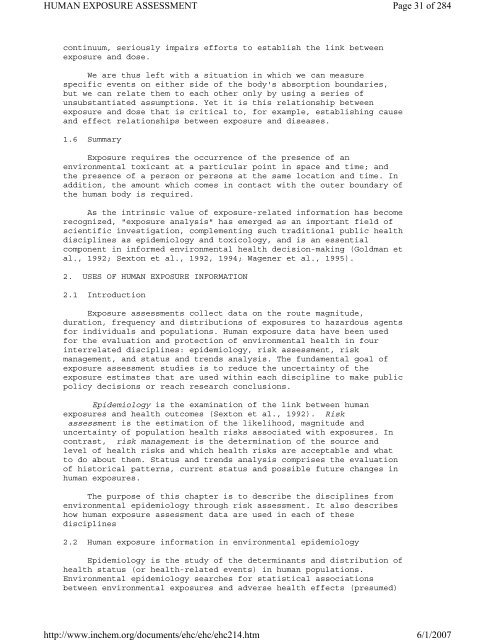Environmental Health Criteria 214
Environmental Health Criteria 214
Environmental Health Criteria 214
You also want an ePaper? Increase the reach of your titles
YUMPU automatically turns print PDFs into web optimized ePapers that Google loves.
HUMAN EXPOSURE ASSESSMENT<br />
continuum, seriously impairs efforts to establish the link between<br />
exposure and dose.<br />
We are thus left with a situation in which we can measure<br />
specific events on either side of the body's absorption boundaries,<br />
but we can relate them to each other only by using a series of<br />
unsubstantiated assumptions. Yet it is this relationship between<br />
exposure and dose that is critical to, for example, establishing cause<br />
and effect relationships between exposure and diseases.<br />
1.6 Summary<br />
Exposure requires the occurrence of the presence of an<br />
environmental toxicant at a particular point in space and time; and<br />
the presence of a person or persons at the same location and time. In<br />
addition, the amount which comes in contact with the outer boundary of<br />
the human body is required.<br />
As the intrinsic value of exposure-related information has become<br />
recognized, "exposure analysis" has emerged as an important field of<br />
scientific investigation, complementing such traditional public health<br />
disciplines as epidemiology and toxicology, and is an essential<br />
component in informed environmental health decision-making (Goldman et<br />
al., 1992; Sexton et al., 1992, 1994; Wagener et al., 1995).<br />
2. USES OF HUMAN EXPOSURE INFORMATION<br />
2.1 Introduction<br />
Exposure assessments collect data on the route magnitude,<br />
duration, frequency and distributions of exposures to hazardous agents<br />
for individuals and populations. Human exposure data have been used<br />
for the evaluation and protection of environmental health in four<br />
interrelated disciplines: epidemiology, risk assessment, risk<br />
management, and status and trends analysis. The fundamental goal of<br />
exposure assessment studies is to reduce the uncertainty of the<br />
exposure estimates that are used within each discipline to make public<br />
policy decisions or reach research conclusions.<br />
Epidemiology is the examination of the link between human<br />
exposures and health outcomes (Sexton et al., 1992). Risk<br />
assessment is the estimation of the likelihood, magnitude and<br />
uncertainty of population health risks associated with exposures. In<br />
contrast, risk management is the determination of the source and<br />
level of health risks and which health risks are acceptable and what<br />
to do about them. Status and trends analysis comprises the evaluation<br />
of historical patterns, current status and possible future changes in<br />
human exposures.<br />
The purpose of this chapter is to describe the disciplines from<br />
environmental epidemiology through risk assessment. It also describes<br />
how human exposure assessment data are used in each of these<br />
disciplines<br />
2.2 Human exposure information in environmental epidemiology<br />
Epidemiology is the study of the determinants and distribution of<br />
health status (or health-related events) in human populations.<br />
<strong>Environmental</strong> epidemiology searches for statistical associations<br />
between environmental exposures and adverse health effects (presumed)<br />
http://www.inchem.org/documents/ehc/ehc/ehc<strong>214</strong>.htm<br />
Page 31 of 284<br />
6/1/2007

















